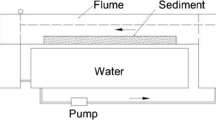Abstract
The combined effects of salinity, temperature, and cadmium on the accumulation of cadmium-binding protein (CdBP) were studied in the grass shrimp,Palaemonetes pugio. In 96-hr bioassays, shrimp were exposed either to zero or to one of three concentrations of cadmium, under one of six different salinity and temperature regimes. Cadmium-binding protein concentrations were quantified in survivors from the 24 exposure groups. Salinity and temperature did not affect survivorship unless the shrimp were also exposed to cadmium.P. pugio produced a 10,000-dalton metallothionein-like CdBP when exposed to at least 0.1 mg Cd2+/L for 96 hr. Accumulation of CdBP was elevated when either the level of cadmium or temperature was increased or salinity was decreased. Grass shrimp surviving the salinitytemperature-cadmium conditions associated with highest mortality exhibited the highest levels of CdBP. Thus, CdBP accumulation is not only related to cadmium exposure, but can be synergistically affected by environmental factors as well. The utility of metal-binding proteins to monitor physiological stress in estuarine biota that inhabit environments polluted with heavy metals is discussed.
Similar content being viewed by others
References
Casterline JL Jr, Yip G (1975) The distribution and binding of cadmium in oyster, soybean, and rat liver and kidney. Arch Environ Contain Toxicol 3:319–329
Eisler R (1971) Cadmium poisoning inFundulus heteroclitus (Pisces: Cyprinodontidae) and other marine organisms. J Fish Res Board Can 28:1225–1234
Eisler R, Hennekey RJ (1977) Acute toxicities of Cd2+, Cr+6, Hg2+, Ni2+ and Zn2+ to estuarine macrofauna. Arch Environ Contam Toxicol 6:315–323
Engel DW, Brouwer M (1982) Detoxification of accumulated trace metals by the American oyster,Crassostrea virginica: Laboratory vs environment. In: Vernberg WB, Calabrese A, Thurberg FP, Vernberg FJ (eds) Physiological mechanisms of marine pollutant toxicity. Academic Press, New York, pp 89–107
— (1984a) Trace metal-binding proteins in marine molluscs and crustaceans. Mar Environ Res 13:177–194
— (1984b) Cadmium-binding proteins in the blue crab,Callinectes sapidus: laboratory—field comparison. Mar Environ Res 14:139–151
— (1986) Cadmium and copper metallothioneins in the American lobster,Homarus americanus. Environ Health Perspec 65:87–92
Finney DJ (1971) Probit analysis. University Press, Cambridge
Fowler BA, Engel DW, Brouwer M (1986) Purification and characterization studies of cadmium-binding proteins from the American oyster,Crassostrea virginica. Environ Health Perspec 65:63–69
Frank PM, Robertson PB (1979) The influence of salinity on toxicity of cadmium and chromium to the blue crab,Callinectes sapidus. Bull Environ Contam Toxicol 21:74–78
George SG (1982) Subcellular accumulation and detoxication of metals in aquatic animals. In: Vernberg WB, Calabrese A, Thurberg FP, Vernberg FJ (eds) Physiological mechanisms of pollutant toxicity. Academic Press, New York, pp 3–51
Hennig HFO (1986) Metal-binding proteins as metal pollution indicators. Environ Health Perspec 65:175–187
Hochachka PW, Somero GN (1984) Biochemical adaptation. Princeton Univ Press, Princeton, NJ
Hutcheson MS (1974) The effect of temperature and salinity on cadmium uptake by the blue crab,Callinectes sapidus. Chesapeake Sci 15:237–241
Jayasekara S, Brown DB, Sharma RP (1986) Tolerance to cadmium and cadmium-binding ligands in Great Salt Lake brine shrimp (Artemia salina). Ecotoxicol Environ Safety 11:23–30
Kito H, Tazawa T, Ose Y, Sato T, Ishikawa T (1982) Formation of metallothionein in fish. Comp Biochem Physiol 73C:129–134
Lerch K, Ammer D, Olafson RW (1981) Amino acid sequence of crab metallothionein. FEBS Lett 126:165–168
O'Hara J (1973) Cadmium uptake by fiddler crabs exposed to temperature and salinity stress. J Fish Res Board Can 30:846–848
Olafson RW, Kearns A, Sim RG (1979a) Heavy metal induction of metallothionein synthesis in the hepatopancreas of the crabScylla serrata. Comp Biochem Physiol 62B:417–424
Olafson RW, Sim RG, Boto KG (1979b) Isolation and chemical characterization of the heavy metal-binding protein metallothionein from marine invertebrates. Comp Biochem Physiol 62B:407–416
Olafson RW, Sim RG, Kearns A (1979c) Physiological and chemical characterization of invertebrate metallothionein-like proteins. In: Kagi JHR, Nordberg M (eds) Metallothionein. Experientia Suppl. 34. Birkhauser Verlag, Basel, Switz, p 197–204
Otvos JD, Olafson RW, Armitage IM (1982) Structure of an invertebrate metallothionein fromScylla serrata. J Biol Chem 257:2427–2431
Overnell J (1986) Occurrence of cadmium in crabs (Cancer pagurus) and the isolation and properties of cadmium metallothionein. Environ Health Perspec 65:101–105
Phillips DJH (1980) Toxicity and accumulation of cadmium in marine and estuarine biota. In: Nriagu JO (ed) Cadmium in the environment. Part I: Ecological cycling. John Wiley and Sons, New York, p 425–569
Rosenberg R, Costlow JD Jr (1976) Synergistic effects of cadmium and salinity combined with constant and cycling temperatures on the larval development of two estuarine crab species. Mar Biol 38:291–303
Stone HC, Wilson SB, Overnell J (1986) Cadmium binding components of scallop (Pecten maximus) digestive gland. Partial purification and characterization. Comp Biochem Physiol 85C:259–268
Sullivan JK (1977) Effects of salinity and temperature on the acute toxicity of cadmium to the estuarine crabParagrapsus gaimardii (Milne Edwards). Austr J Mar Freshwater Res 28:739–743
Sunda WG, Engel DW, Thuotte RM (1978) Effect of chemical speciation on toxicity of cadmium to grass shrimp,Palaemonetes pugio: Importance of free cadmium ion. Engineer Sci Technol Res 12:409–413
Wiedow MA, Kneip TJ, Garte SJ (1982) Cadmium-binding proteins from blue crabs (Callinectes sapidus) environmentally exposed to cadmium. Environ Res 28:164–170
Woodworth J, Evans ASA, Pascoe D (1983) The production of cadmium-binding protein in three species of freshwater fish. Toxicol Lett 15:289–295
Yamamura M, Hatakeyama S, Suzuki KT (1983) Cadmium uptake and induction of cadmium-binding protein in the waterflea (Moina macrocopa). Bull Environ Contam Toxicol 30:298–302
Author information
Authors and Affiliations
Rights and permissions
About this article
Cite this article
Howard, C.L., Hacker, C.S. Effects of salinity, temperature, and cadmium on cadmium-binding protein in the grass shrimp,Palaemonetes pugio . Arch. Environ. Contam. Toxicol. 19, 341–347 (1990). https://doi.org/10.1007/BF01054976
Received:
Revised:
Issue Date:
DOI: https://doi.org/10.1007/BF01054976




